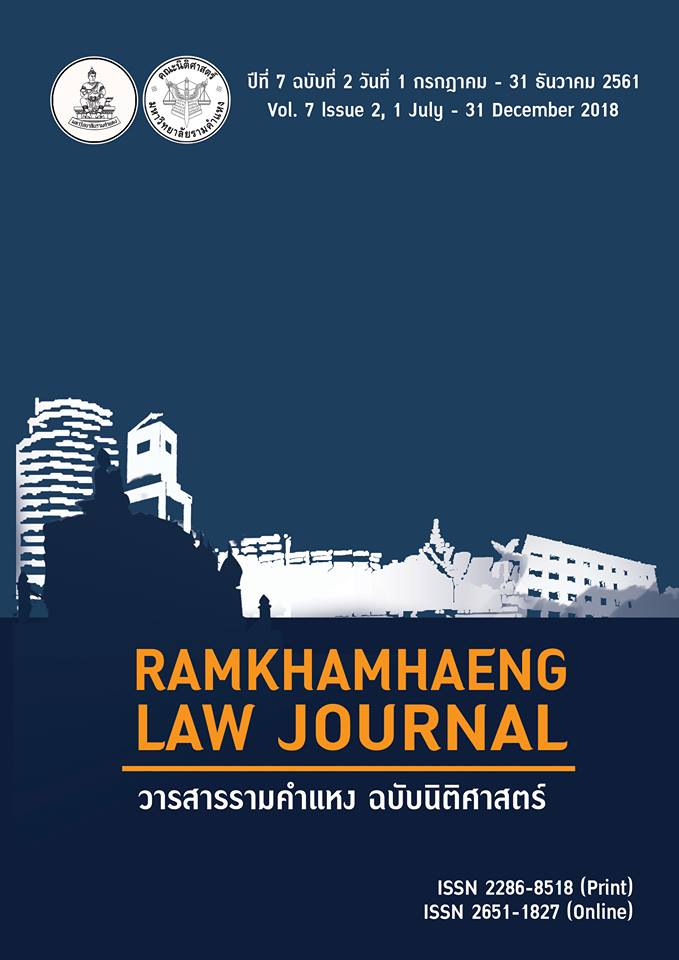The Assessment of the ASEAN Agreement on Transboundary Haze Pollution and the Dispute Settlement Mechanisms on Liability Claims
Main Article Content
Abstract
The objective of this article is to examine the effectiveness of the ASEAN Agreement on Transboundary Haze Pollution (ATHP) and the Dispute Settlement Mechanisms on Liability Claims. In Southeast Asia, transboundary haze pollution, particularly from Indonesia’s forest fires created massive transboundary haze pollution and had a devastating effect on biodiversity in the world. ASEAN has initiated several relevant plans to cope with the transboundary environmental crisis. However, the “ASEAN Ways” which referred to a regional style of engagement, dealing on a “consultation” and “consensus” basis, has causing the ATHP to be ineffective. Furthermore, the non-intervention policy of ASEAN member, the domestic politics, the patronage networks and corruption within Indonesia, have caused the ATHP to be ineffectiveness mechanism on its own for dealing with transboundary haze pollution. In this regard, the possible solutions under the ASEAN Charter will be examined.
Article Details
References
. Constucting a Security Community in Southeast Asia: ASEAN and the problem of regional order. 2nd ed. Routledge: Oxon, 2009.
. Corporation Constructing a Security Community in Southeast Asia: ASEAN and the Problem of Regional Order. 3rd ed. New York: Routledge, 2014
Brittany Patterson. Hellish Fires in Indonesia Spread Health, Climate Problems [Online]. Available URL: https://www.scientificamerican.com/article/hellish-fires-in-indonesia-spread-health-climate-problems, 2015 (October, 22).
Case Concerning Sovereignty Over PulauLitigan and PulanSipadan (Indonesia v. Malaysia) Judgment of 17 December 2002.
Florano, Ebinezer R. “Assessment of the "Strengths" of the New ASEAN Agreement on Transboundary Haze Pollution.” International Review for Environmental Strategies, 4 (1), (2003): 139.
Goh, Gillian. “The “ASEAN Way”: Non-Intervention and ASEAN’s Role in Conflict Management.” Stanford Journal of East Asian 3, 1 (2003): 113-118, at 114.
Harris, Nancy, et. al. Indonesia’s Fire Outbreaks Producing More Daily Emissions than Entire US Economy [Online]. Available URL: http://www.wri.org/blog/2015/10/
indonesia%E2%80%99s-fire-outbreaks-producing-more-daily-emissions-entire-us-economy, 2015 (October, 16).
Jerger, David B., Jr. “Indonesia’s role in realising the goals of ASEAN Agreement on Transboundary Haze Pollution.” Sustainable Development Law & Policy 14, 1 (2014): 42.
Kraichitti, Krit. Dispute Settlement Mechanisms for ASEAN Community: Experiences, Challenges and Way Forward [Online]. Available URL: https://www.aseanlawassociation.org/12GAdocs/workshop5-thailand.pdf, 2015 (June, 11).
Leviter, Lee. “The ASEAN Charter: ASEAN Failure or Member Failure?.” International Law and Politics 43 (1) (2010): 166.
Lian, Koh Kheng. “ASEAN Environmental Protection in Natural Resources and Sustainable Development: Convergence versus Divergence?.” Macquarie Journal of International and Comparative Environmental Law 4 (2007): 46
. and Nicholas A. Robinson, “Regional Environmental Governance: Examining the Association of Southeast Asian Nations (ASEAN) Model.” Global Environmental Governance (2002): 4-5.
Mayer, Judith. “Transboundary Perspectives on Managing Indonesia’s Fires.” The Journal of Environment & Development 15 (2) (2006): 205.
Mongabay. The Asian Forest Fires of 1997-1998 [Online]. Available URL: https:// rainforests. mongabay.com/08indo_fires.htm, 2016 (March, 7).
Neo Chai Chin. Singapore effort to fight haze ‘almost futile’ [Online]. Available URL: https://www.todayonline.com/singapore/singapores-fire-fighting-team-went-indonesia-too-late-masagos, 2015 (October, 30).
Nguitragool, Paruedee. Environment Cooperation in Southeast Asia ASEAN's Regime for Transboundary Haze Pollution. Abingdon, Oxon.: Routledge, 2011.
Nurhidayah, L., Alam, S. and Lipman, Z. “The influence of international law upon ASEAN approaches in addressing transboundary haze pollution in Southeast Asia.” Contemporary Southeast Asia 37, 2 (2015): 191.
Okowa, Phoebe N. State Responsibility for Transboundary Air Pollution in International Law. New York: Oxford University Press, 2000.
Reif, Linda C. “Conciliation As A Mechanism For The Resolution Of International Economic And Business Disputes.” Fordham International Law Journal 14 (3) (1990): 580.
Severino, Rodolfo C. ASEAN Today and Tomorrow: Selected speeches of Rodolfo C. Severino, Jr. Jakarta: ASEAN Secretariat, 2002.
T., Nathalie L. J., Horbach and Pieter H. F. Bekker. “State Responsibility for Injurious Transboundary Activity in Retrospect.” Netherlands International Law Review 50, 3 (2003): 328.
Tahir, S. Qadri. Fire, Smoke, and Haze: The ASEAN Response Strategy. 1st ed. Manila: Asia Development Bank, 2001.
Tan, Alan Khee-Jin. “Forest fires of Indonesia: State responsibility and international liability.” Comparative Law Quarterly, 48, 4 (1999): 834.
. “The ASEAN Agreement on Transboundary Haze Pollution: Prospects for Compliance and Effectiveness in Post-Suharto Indonesia.” New York University Environmental Law Journal 13, 3 (2005): 653-654.
United Nations, A More Secure World: Our Shared Responsibility, A Report of the High-level Panel on Threats, Challenges and Change [Online]. Available URL: www.un.org., 2015 (October, 18).
Varkkey, Helena M. “Addressing Transboundary Haze Through Asean: Singapore's Normative Constraints.” Journal of International Studies 7 (2011): 83-101, at 86.
. “Indonesia Perspectives on Managing the ASEAN Haze.” Sarjana 24, 1 (2009) 83-101, at 83-85.
Varkkey, Helena M. “Regional cooperation, Patronage and the ASEAN Agreement on Transboundary Haze Pollution.” International Environmental Agreements: Politics, Law and Economics 14, 1 (2014): 65–81, at 68.
Victor, Charles and Barber James Schweithelm. Trial by Fire: Forest Fires and Forestry Policy in Indonesia’s era of Crisis and Reform. Washington, DC: World Resources Institute Report, 2000.
Draft articles on Prevention of Transboundary Harm from Hazardous Activities.
Government of Singapore, Government Gazette Acts Supplement, No. 24 of 2014.
International Law Commission (ILC)'s 1996 Draft Rules on State Responsibility.
Protocol to The ASEAN Charter on Dispute Settlement Mechanisms 2010.
The Bangkok Declaration, 8 August 1967, the Preamble.

